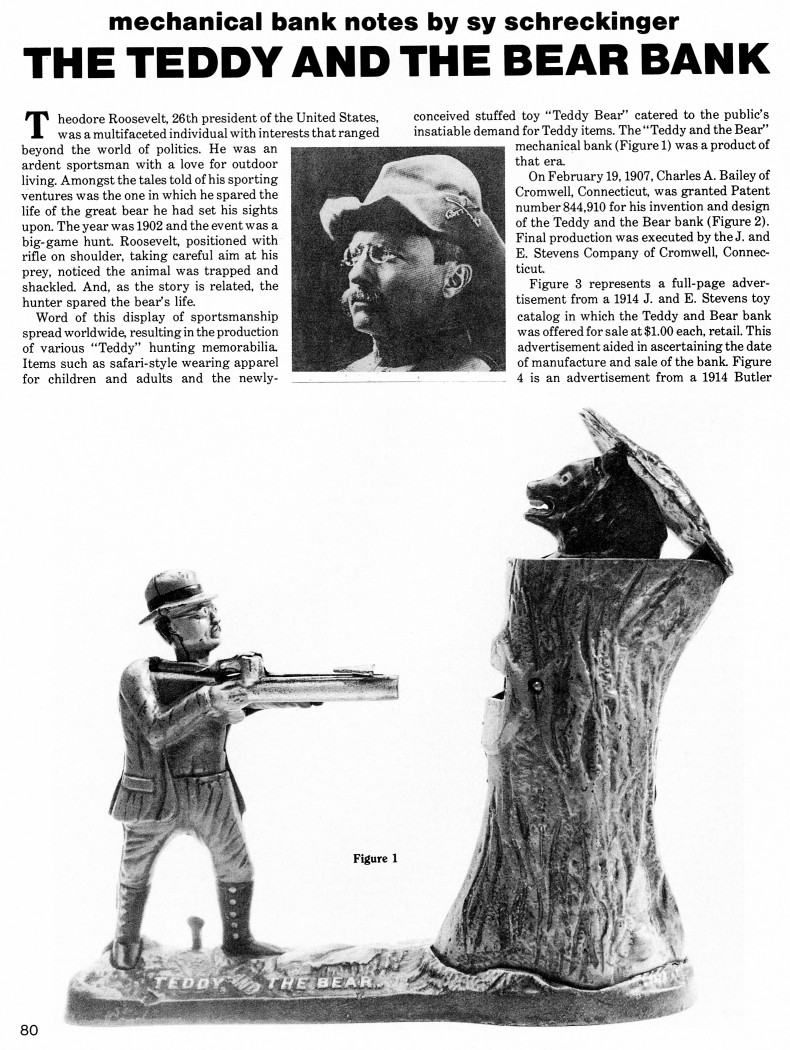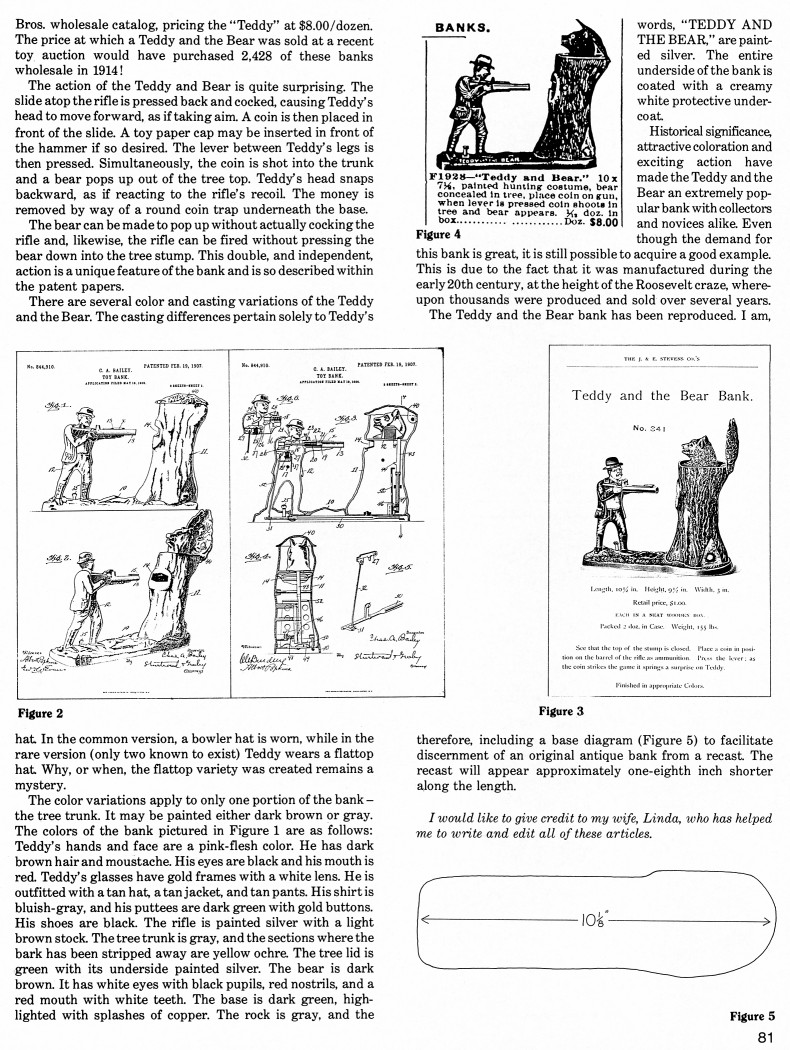|
The Teddy and the Bear
Bank
by Sy Schreckinger – ANTIQUE TOY WORLD Magazine – December,
1986
Theodore Roosevelt,
26th president of the United States, was a multifaceted individual with
interests that ranged beyond the world of politics. He was an ardent
sportsman with a love for outdoor living. Amongst the tales told of his
sporting ventures was the one in which he spared the life of the great
bear he had set his sights upon. The year was 1902 and the event was a
big-game hunt. Roosevelt, positioned with rifle on shoulder, taking
careful aim at his prey, noticed the animal was trapped and shackled. And,
as the story is related, the hunter spared the bear's life.
Word of this display of sportsmanship spread worldwide, resulting in
the production of various "Teddy" hunting memorabilia. Items such as
safari-style wearing apparel for children and adults and the
newly-conceived stuffed toy "Teddy Bear" catered to the public's
insatiable demand for Teddy items. The "Teddy and the Bear" mechanical
bank (Figure 1) was a product of that era.
On February 19, 1907, Charles A. Bailey of Cromwell, Connecticut, was
granted Patent number
844,910 for his invention and design of the Teddy
and the Bear bank (Figure 2). Final production was executed by the J. and
E. Stevens Company of Cromwell, Connecticut.
Figure 3 represents a full-page advertisement from a 1914 J. and E.
Stevens toy catalog in which the Teddy and Bear bank was offered for sale
at $1.00 each, retail. This advertisement aided in ascertaining the date
of manufacture and sale of the bank. Figure 4 is an advertisement from a
1914 Butler Bros. wholesale catalog, pricing the "Teddy" at $8.00/dozen.
The price at which a Teddy and the Bear was sold at a recent toy auction
would have purchased 2,428 of these banks wholesale in 1914!
The action of the Teddy and Bear is quite surprising. The slide atop
the rifle is pressed back and cocked, causing Teddy's head to move
forward, as if taking aim. A coin is then placed in front of the slide. A
toy paper cap may be inserted in front of the hammer if so desired. The
lever between Teddy's legs is then pressed. Simultaneously, the coin is
shot into the trunk and a bear pops up out of the tree top. Teddy's head
snaps backward, as if reacting to the rifle's recoil. The money is removed
by way of a round coin trap underneath the base.
The bear can be made to pop up without actually cocking the rifle
and, likewise, the rifle can be fired without pressing the bear down into
the tree stump. This double, and independent, action is a unique feature
of the bank and is so described within the patent papers.
There are several color and casting variations of the Teddy and the
Bear. The casting differences pertain solely to Teddy's hat. In the common
version, a bowler hat is worn, while in the rare version (only two known
to exist) Teddy wears a flattop hat. Why, or when, the flattop variety was
created remains a mystery.
The color variations apply to only one portion of the bank – the tree
trunk. It may be painted either dark brown or gray. The colors of the bank
pictured in Figure 1 are as follows: Teddy's hands and face are a
pink-flesh color. He has dark brown hair and moustache. His eyes are black
and his mouth is red. Teddy's glasses have gold frames with a white lens.
He is outfitted with a tan hat, a tan jacket, and tan pants. His shirt is
bluish-gray, and his puttees are dark green with gold buttons. His shoes
are black. The rifle is painted silver with a light brown stock. The tree
trunk is gray, and the sections where the bark has been stripped away are
yellow ochre. The tree lid is green with its underside painted silver. The
bear is dark brown. It has white eyes with black pupils, red nostrils, and
a red mouth with white teeth. The base is dark green, highlighted with
splashes of copper. The rock is gray, and the words, "TEDDY AND THE BEAR,"
are painted silver. The entire underside of the bank is coated with a
creamy white protective undercoat.
Historical significance, attractive coloration and exciting action
have made the Teddy and the Bear an extremely popular bank with collectors
and novices alike. Even though the demand for this bank is great, it is
still possible to acquire a good example. This is due to the fact that it
was manufactured during the early 20th century, at the height of the
Roosevelt craze, whereupon thousands were produced and sold over several
years.
The Teddy and the Bear bank has been reproduced. I am, therefore,
including a base diagram (Figure 5) to facilitate discernment of an
original antique bank from a recast. The recast will appear approximately
one-eighth inch shorter along the length.
I would like to give credit to my wife, Linda, who has helped me to
write and edit all of these articles.
|


